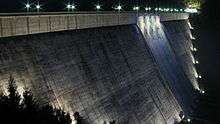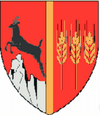Bicaz
Bicaz is a town in Neamț County, Western Moldavia, Romania situated in the eastern Carpathian Mountains near the confluence of the Bicaz and Bistrița Rivers and near Lake Bicaz, an artificial lake formed by the Bicaz Dam on the Bistrița. Bicaz used to be a border town until 1918. Six villages are administered by the town: Capșa, Dodeni, Izvoru Alb, Izvoru Muntelui, Potoci and Secu.
| Year | Pop. | ±% |
|---|---|---|
| 1966 | 8,368 | — |
| 1977 | 9,477 | +13.3% |
| 1992 | 8,581 | −9.5% |
| 2002 | 8,911 | +3.8% |
| 2011 | 6,298 | −29.3% |
| Source: Census data | ||
Bicaz | |
|---|---|
 Coat of arms | |
 Location in Neamț County | |
 Bicaz Location in Romania | |
| Coordinates: 46°54′39″N 26°5′28″E | |
| Country | |
| County | Neamț |
| Government | |
| • Mayor | Nicolae Sălăgean[1] (PSD) |
| Area | 148.9 km2 (57.5 sq mi) |
| Population (2011)[2] | 6,543 |
| • Density | 44/km2 (110/sq mi) |
| Time zone | EET/EEST (UTC+2/+3) |
| Vehicle reg. | NT |
Economy
Before the construction of the dam (1950–1960) the settlement was just a mountain village in Eastern Carpathians where the main economic activity was timber harvesting. By tradition, the tree trunks were linked together, forming a raft (pluta); a raftman (Romanian: plutaş) used to drive the raft on the Bistriţa river downstream to wood processing facilities in Piatra Neamț.
Building the dam created also a horizontal industry: two cement and aggregate plants were built in Bicaz proper and nearby Tașca. This, together with the construction of the Bicaz-Stejaru Hydro Power Plant (10 km to the east) triggered a relative economic boom during the communist period.
Bicaz cement plant was shut down after the Romanian Revolution of 1989 and is slowly being taken apart. On the other hand, the Tașca cement plant was acquired by the German group HeidelbergCement and completely overhauled.[3] The town has also a few timber factories and wood processing facilities.
Access
The town has access to two national roads: DN15 ![]()
![]()
Tourism
The town is located in the proximity of two important tourist destinations in Romania: Ceahlău Massif (12 km north) and Cheile Bicazului-Hășmaș National Park (25 km to the west). The impressive Bicaz Dam built on the river Bistrița in the 1950s (one of the biggest in Romania) and the resulted Bicaz Lake are also popular tourist sights. Durău, the only ski resort in Ceahlău is located about 30 km north.
Image gallery
 Bicaz Town Hall
Bicaz Town Hall- Bicaz Dam, 127 meters high, built between 1950 and 1960 on the Bistrița River
 Night view of the dam
Night view of the dam Bicaz Canyon, a narrow pass linking Romanian historical regions of Moldavia and Transylvania along DN12C national road
Bicaz Canyon, a narrow pass linking Romanian historical regions of Moldavia and Transylvania along DN12C national road
See also
- Bicaz River
- Bicaz Canyon
- Bicaz Dam
- Lake Bicaz
- Bicaz-Stejaru Hydro Power Plant
- Ceahlău Massif
References
| Wikimedia Commons has media related to Bicaz. |
- "Results of the 2016 local elections". Central Electoral Bureau. Retrieved 5 April 2020.
- "Populaţia stabilă pe judeţe, municipii, oraşe şi localităti componenete la RPL_2011" (in Romanian). National Institute of Statistics. Retrieved 4 February 2014.
- Romania - HeidelbergCement Group
